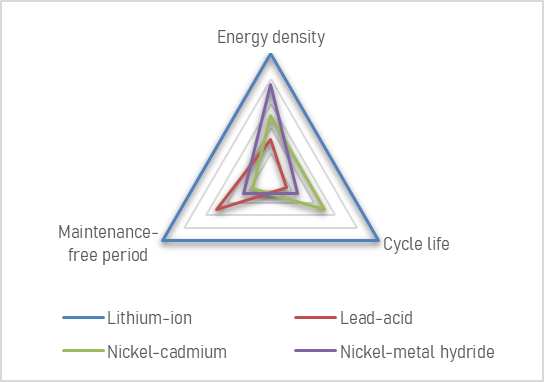Over the last decade, lithium-ion batteries (LIBs) have seen a meteoric rise in deployment. They are preferred in consumer electronics, in electric vehicles (EVs), and for grid support. In 2018, the LIB market size of USD 40 billion was already seven per cent greater than lead-acid batteries. Annual deployment grew to 195 GWh in 2019 from a paltry 60 GWh five years prior.1 In this article we discuss the reasons behind the rapidly growing popularity of LIBs.
High energy density
The most apparent difference between LIBs and other established technologies is the energy density. Lithium is the lightest metal and possesses a high electrochemical potential which allows LIBs to have extremely high energy densities; much higher than nickel-cadmium (Ni-Cd), nickel-metal hydride (NiMH) and lead-acid (Pb-Acid) batteries.2 This makes LIBs ideal for applications such as mobile phones or EVs, where excess weight is a liability.
Long cycle life
The long cycle life of LIBs has further enhanced their popularity. Products that contain these batteries can reach the end of their product life without requiring a battery change. Also, the current higher costs of lithium-ion – with respect to lead-acid, for instance – can be significantly offset by the much longer cycle life of the battery. A lead-acid battery may have to be replaced several times over the lifespan of the product.
Zero maintenance
LIBs are essentially zero maintenance, without the need for intermittent charging and discharging required to prolong the battery’s life. The self-discharge of the battery is minimal, and it doesn’t need a topping charge to maintain its original state-of-charge (SOC). LIBs don’t show the battery memory effect common in NiMH and Ni-Cd batteries, which causes a loss of capacity when partially charged and discharged repeatedly.3
Versatility
A single type of lithium-ion cell (the functional unit that makes up a battery), such as a cylindrical 21700 cell, can be used in a torch4 brought together into a EV battery pack, or even be used in a large grid-connected energy storage installation5. This versatility allows manufacturers to greatly scale production of specific cell architectures, bringing prices of lithium-ion batteries down considerably.
Figure 1: Lithium-ion scores over other rechargeable battery technologies

Source: Battery University. 2017. “What’s the Best Battery?” 21 March. Accessed June 24, 2021. https://batteryuniversity.com/article/whats-the-best-battery.
Relevance and impact
- The global energy-storage market is expected to grow to a 2.5 TWh annual deployment by 2030. This will be driven primarily by electric mobility, along with deployment of stationary energy storage1. As of today, this growth is expected to be based on the growing use of LIBs, which could account for as much as 80 per cent of total energy storage deployment1.
- New battery technologies – such as sodium-ion, metal-air and solid state – will be commercialised in the coming years, and are expected to compete with LIBs.
Who should care?
- Policymakers
- Battery manufacturers
- EV companies and renewable energy developers
- R&D institutions working on battery storage technologies
References
- [1] US-DoE, “Energy Storage Grand Challenge: Energy Storage Market Report,” U.S. Department of Energy, 2020.
- [2] Battery University, “What's the Best Battery?,” 21 March 2017. [Online]. Available: https://batteryuniversity.com/article/whats-the-best-battery. [Accessed 24 June 2021].
- [3] H. Bergveld, Battery Management Systems: Design by Modelling, Eindhoven: Royal Philips Electronics N.V. , 2001.
- [4] Fenix Store, “21700 Batteries, are they better than 18650 batteries?,” [Online]. Available: https://www.fenix-store.com/blog/21700-batteries-are-they-better-than-18650-batteries/. [Accessed 24 June 2021].
- [5] I. Clover, “Elon Musk comes good on 100-day, 100 MW South Australia battery promise,” 1 December 2017. [Online]. Available: https://www.pv-magazine.com/2017/12/01/elon-musk-comes-good-on-100-day-100-mw-south-australia-battery-promise/. [Accessed 24 June 2021].



